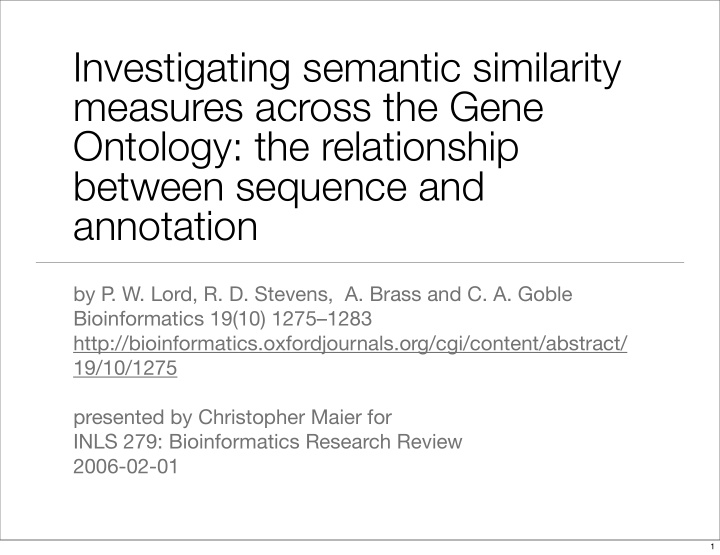



Investigating semantic similarity measures across the Gene Ontology: the relationship between sequence and annotation by P . W. Lord, R. D. Stevens, A. Brass and C. A. Goble Bioinformatics 19(10) 1275–1283 http://bioinformatics.oxfordjournals.org/cgi/content/abstract/ 19/10/1275 presented by Christopher Maier for INLS 279: Bioinformatics Research Review 2006-02-01 1
Overall Concept • Use the addition of ontological annotations to create a new search layer on top of biological databases: semantic querying, to find entries that “mean” the same thing 2
What is an Ontology? 3
“A Conceptualization of a Specification” • Originally a tool from philosophy to convey the existence and relationships of all that exists • Now used as a formal method to define important concepts and relationships in a particular domain • More powerful than controlled vocabularies due to added logical infrastructure; more powerful than taxonomies due to additional relationships 4
The Gene Ontology • Contains three different “sub-ontologies”: molecular function, cellular component, and biological process • 20,349 total terms as of December 2005 • Annotations in numerous databases • http://www.geneontology.org, http://www.godatabase.org/ 5
Defining and Validating Semantic Similarity 6
Approaches to Ontological Similarity • Path Distance • Depth • These approaches don’t seem to perform well in the biological domain 7
Figure 1 GO Fragment 8
Our Definition of Similarity • Count number of times a term appears (including implicit appearances due to subsumption relationships) • The less frequent a term, the more informative it is • Probability of the minimum subsumer for multiple parentage • Similarity is a negative log function 9
Validation of Semantic Similarity • Hard to use traditional validation approaches • See if sequence similarity tracks with semantic similarity 10
Why Sequence Similarity? • Properties of biological macromolecules such as DNA and proteins ultimately derive from their sequence • Thus, proteins with very similar sequence will generally fold into a very similar 3D shape, allowing them to perform similar functions • This serves as an empirical measure of similarity, against which our ontological measure can be proven 11
Adapting to SWISS-PROT • Orphan Terms • “part-of” terms do not participate in “is-a” relationships! • Link these back to the ontology root, despite semantic impoverishment • Link Type Bias • Large majority of “molecular function” is “is-a”; over half of “cellular component” is “part-of” • Multiple Annotations • Take average 12
Figure 2 Similarity Correlations in GO 13
Figure 3 Similarity and Evidence Codes 14
Figure 4 Correlation with links removed 15
Outliers • Polymorphic groups: different proteins participate in the same process • Hyper-variable families • Mis-annotations • Under-annotation 16
Application: Semantic Search 17
Search • Utilize semantic similarity to provide alternative search axes • Each of the three sub-ontologies of GO retrieves a different kind of “similar” proteins 18
Table 4 Semantic Search Results 19
Conclusion 20
What have we learned? • Semantic similarity is valid concept • Ontology structure adds value above controlled vocabulary • Possible uses: semantic search, error detection 21
The Future • As GO grows both in size and in use, the value of semantic searching on GO annotations will increase • What other similarity functions could be used? • Are there other measures with which cellular component and biological process similarity are correlated? 22
Recommend
More recommend